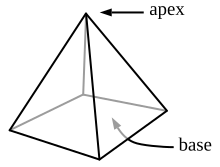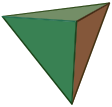Pyramid (geometry)
In
Definition

A pyramid is a polyhedron that may be formed by connecting a polygonal base and a point, called the
A prismatoid is defined as a polyhedron where its vertices lie on two parallel planes, with its lateral faces are triangles, trapezoids, and parallelograms.[6] Pyramids are classified as prismatoid.[7]
Classification and types
A right pyramid is a pyramid where the base is circumscribed about the circle and the altitude of the pyramid meets at the circle's center.
A right pyramid may also have a base with an irregular polygon. Examples are the pyramids with rectangle and rhombus as their bases. These two pyramids have the symmetry of C2v of order 4.
The type of pyramids can be derived in many ways. The base regularity of a pyramid's base may be classified based on the type of polygon, and one example is the pyramid with
Mensuration
The surface area is the total area of each polyhedra's faces. In the case of a pyramid, its surface area is the sum of the area of triangles and the area of the polygonal base.
The volume of a pyramid is the one-third product of the base's area and the height. Given that is the base's area and is the height of a pyramid. Mathematically, the volume of a pyramid is:[19]
Generalization

The hyperpyramid is the generalization of a pyramid in n-dimensional space. In the case of the pyramid, one connects all vertices of the base, a polygon in a plane, to a point outside the plane, which is the
The n-dimensional volume of a n-dimensional hyperpyramid can be computed as follows:
References
- ^ "Henry George Liddell, Robert Scott, A Greek-English Lexicon, πυραμίς", www.perseus.tufts.edu.
- ^ The word meant "a kind of cake of roasted wheat-grains preserved in honey"; the Egyptian pyramids were named after its form. See Beekes, Robert S. (2009), Etymological Dictionary of Greek, Brill, p. 1261.
- ^ Cromwell, Peter R. (1997), Polyhedra, Cambridge University Press, p. 13.
- ISBN 0-471-25183-6.
- ^ Heath, Thomas (1908), Euclid: The Thirteen Books of the Elements, vol. 3, Cambridge University Press, p. 268.
- ^ Alsina, Claudi; Nelsen, Roger B. (2015), A Mathematical Space Odyssey: Solid Geometry in the 21st Century, Mathematical Association of America, p. 85.
- .
- ^ Polya, G. (1954), Mathematics and Plausible Reasoning: Induction and analogy in mathematics, Princeton University Press, p. 138.
- ^ O'Leary, Michael (2010), Revolutions of Geometry, John Wiley & Sons, p. 10.
- ^ Humble, Steve (2016), The Experimenter's A-Z of Mathematics: Math Activities with Computer Support, Taylor & Francis, p. 23.
- ISBN 978-1-107-10340-5. See Chapter 11: Finite Symmetry Groups, 11.3 Pyramids, Prisms, and Antiprisms.
- ISBN 978-0-486-48813-4.
- Zbl 0132.14603. See table III, line 1.
- ISBN 978-981-15-4470-5.
- ^ Kelley, W. Michael (2009), The Humongous Book of Geometry Problems, Penguin Group, p. 455.
- ISBN 978-3-319-95588-9
- ISBN 978-0-8176-8363-4.
- ISBN 978-0-521-09859-5, archivedfrom the original on 2013-12-11
- ISBN 978-1-285-19569-8.
- JSTOR 27957144.
- ISBN 978-1-4704-7059-3.
- ^ a b Mathai, A. M. (1999), An Introduction to Geometrical Probability: Distributional Aspects with Applications, Taylor & Francis, p. 42–43.












